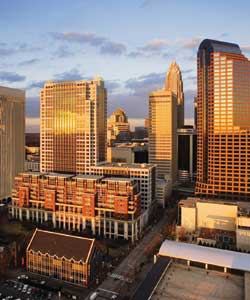Suburban Stock
While competition from the single-family home market has considerably reined in multifamily construction in Charlotte’s suburbs, there are a few pockets of activity. Charlotte’s growth pattern traditionally has traveled to the southeast, with the area between uptown and the Interstate Highway 485 corridor containing more than a quarter of all the existing apartments in the metro. The hot growth pocket in the southeastern part of the metro is the Ballantyne area, located along Interstate Highway 485. Ballantyne has a very sizable job base in its own right, as the upscale office parks here have become the metro’s preferred suburban corporate location. This concentration of jobs triggered development of a slew of luxury apartment communities along Ballantyne Commons Parkway during recent years.
Turning to Charlotte’s north side, new apartments also are coming on stream at the northeastern edge of the metro, particularly along the W.T. Harris Boulevard corridor north of Interstate Highway 85. The University of North Carolina-Charlotte, with an enrollment of 20,700 students, is the anchor for this part of town, and there’s also a sizable job base at the associated University Research Park business center. Moving due north from uptown Charlotte, the city of Huntersville lies about 10 miles away along Interstate Highway 77. Huntersville’s population has grown to about 38,000 people, up from just 3,000 in 1990. Most notably, Huntersville now has a town-center-style development called Birkdale Village that combines 320 apartments with more than five dozen mostly upscale retailers. Additional apartment communities are on the way immediately around Birkdale Village.
It’s no surprise that Charlotte routinely is cited among America’s most livable cities. The local economy has turned into a job production machine, and affordable housing costs make the area incredibly attractive to young professionals still in the early stages of their careers. Most existing neighborhoods are managing to evolve while retaining the charm that made them appealing in the first place, and new neighborhoods are emerging in areas that lie within reasonable commuting distance from established job centers.
Potential demand for multifamily housing in Charlotte appears likely to be quite healthy for the foreseeable future, allowing occupancy to hold at favorable levels. But investors must take into consideration that rent growth prospects aren’t among the rosiest nationwide. Charlotte simply can’t sustain the sort of price bumps that are routine in areas with more limited land availability and much higher premiums to buy versus rent housing.
–Greg Willett is vice president of research and analysis at Dallas-based M/PF YieldStar.
